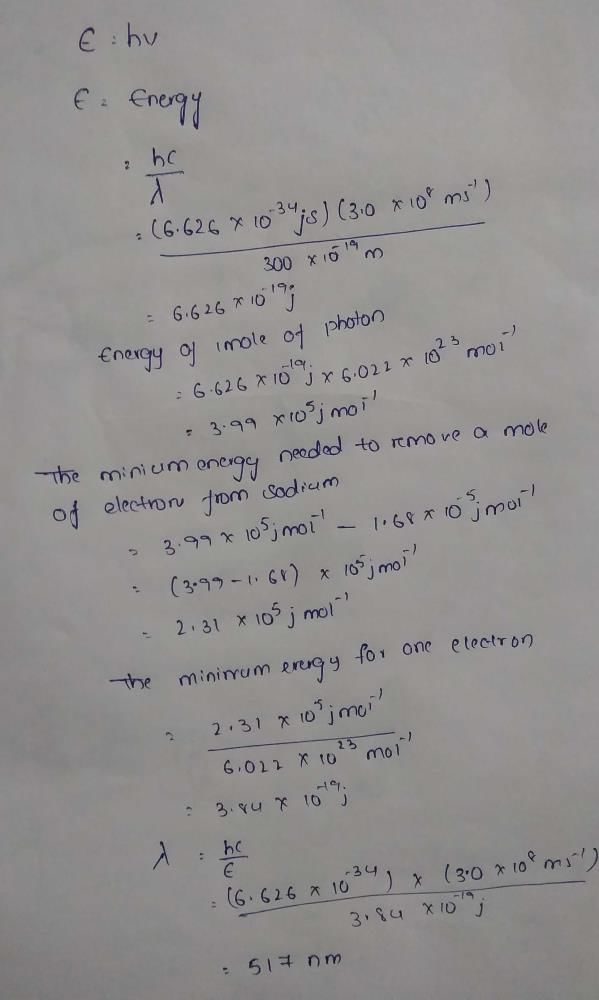NEET Exam > NEET Questions > When electromagnetic radiation of wavelength ...
Start Learning for Free
When electromagnetic radiation of wavelength 300nm falls on the surface of sodium electrons are emitted with a kinetic energy of 1.68×100000j/mole. The maximum wave length that will cause a photo electron to be emitted is?
Most Upvoted Answer
When electromagnetic radiation of wavelength 300nm falls on the surfac...

Community Answer
When electromagnetic radiation of wavelength 300nm falls on the surfac...
Given:
Wavelength of incident radiation (λ) = 300 nm
Kinetic energy of emitted electrons (KE) = 1.68 × 10^5 J/mol
To find:
The maximum wavelength that will cause a photoelectron to be emitted.
Explanation:
When electromagnetic radiation falls on the surface of a metal, it can transfer its energy to the electrons in the metal. If the energy of the incident radiation is sufficient to overcome the binding energy of the electrons, they are emitted from the metal surface. This phenomenon is known as the photoelectric effect.
The energy of a photon is given by the equation:
E = hc/λ
Where:
E is the energy of the photon
h is Planck's constant (6.626 × 10^-34 J·s)
c is the speed of light (3.0 × 10^8 m/s)
λ is the wavelength of the radiation
When the incident radiation has sufficient energy to overcome the binding energy, the excess energy is converted into the kinetic energy of the emitted electrons. The kinetic energy of the emitted electrons can be determined using the equation:
KE = E - Φ
Where:
KE is the kinetic energy of the emitted electrons
E is the energy of the incident photon
Φ is the work function (binding energy) of the metal
In this case, the kinetic energy of the emitted electrons is given as 1.68 × 10^5 J/mol.
Step 1: Calculate the energy of the incident photon using the given wavelength.
E = hc/λ
E = (6.626 × 10^-34 J·s × 3.0 × 10^8 m/s) / (300 × 10^-9 m)
E = 6.626 × 10^-19 J
Step 2: Calculate the work function of sodium.
Φ = E - KE
Φ = (6.626 × 10^-19 J) - (1.68 × 10^5 J/mol)
Φ ≈ 6.626 × 10^-19 J
Step 3: Calculate the maximum wavelength that will cause a photoelectron to be emitted.
E = hc/λ
λ = hc/E
λ = (6.626 × 10^-34 J·s × 3.0 × 10^8 m/s) / (6.626 × 10^-19 J)
λ = 3.0 × 10^-7 m
Therefore, the maximum wavelength that will cause a photoelectron to be emitted is approximately 300 nm.
Wavelength of incident radiation (λ) = 300 nm
Kinetic energy of emitted electrons (KE) = 1.68 × 10^5 J/mol
To find:
The maximum wavelength that will cause a photoelectron to be emitted.
Explanation:
When electromagnetic radiation falls on the surface of a metal, it can transfer its energy to the electrons in the metal. If the energy of the incident radiation is sufficient to overcome the binding energy of the electrons, they are emitted from the metal surface. This phenomenon is known as the photoelectric effect.
The energy of a photon is given by the equation:
E = hc/λ
Where:
E is the energy of the photon
h is Planck's constant (6.626 × 10^-34 J·s)
c is the speed of light (3.0 × 10^8 m/s)
λ is the wavelength of the radiation
When the incident radiation has sufficient energy to overcome the binding energy, the excess energy is converted into the kinetic energy of the emitted electrons. The kinetic energy of the emitted electrons can be determined using the equation:
KE = E - Φ
Where:
KE is the kinetic energy of the emitted electrons
E is the energy of the incident photon
Φ is the work function (binding energy) of the metal
In this case, the kinetic energy of the emitted electrons is given as 1.68 × 10^5 J/mol.
Step 1: Calculate the energy of the incident photon using the given wavelength.
E = hc/λ
E = (6.626 × 10^-34 J·s × 3.0 × 10^8 m/s) / (300 × 10^-9 m)
E = 6.626 × 10^-19 J
Step 2: Calculate the work function of sodium.
Φ = E - KE
Φ = (6.626 × 10^-19 J) - (1.68 × 10^5 J/mol)
Φ ≈ 6.626 × 10^-19 J
Step 3: Calculate the maximum wavelength that will cause a photoelectron to be emitted.
E = hc/λ
λ = hc/E
λ = (6.626 × 10^-34 J·s × 3.0 × 10^8 m/s) / (6.626 × 10^-19 J)
λ = 3.0 × 10^-7 m
Therefore, the maximum wavelength that will cause a photoelectron to be emitted is approximately 300 nm.
Attention NEET Students!
To make sure you are not studying endlessly, EduRev has designed NEET study material, with Structured Courses, Videos, & Test Series. Plus get personalized analysis, doubt solving and improvement plans to achieve a great score in NEET.

|
Explore Courses for NEET exam
|

|
Similar NEET Doubts
When electromagnetic radiation of wavelength 300nm falls on the surface of sodium electrons are emitted with a kinetic energy of 1.68×100000j/mole. The maximum wave length that will cause a photo electron to be emitted is?
Question Description
When electromagnetic radiation of wavelength 300nm falls on the surface of sodium electrons are emitted with a kinetic energy of 1.68×100000j/mole. The maximum wave length that will cause a photo electron to be emitted is? for NEET 2024 is part of NEET preparation. The Question and answers have been prepared according to the NEET exam syllabus. Information about When electromagnetic radiation of wavelength 300nm falls on the surface of sodium electrons are emitted with a kinetic energy of 1.68×100000j/mole. The maximum wave length that will cause a photo electron to be emitted is? covers all topics & solutions for NEET 2024 Exam. Find important definitions, questions, meanings, examples, exercises and tests below for When electromagnetic radiation of wavelength 300nm falls on the surface of sodium electrons are emitted with a kinetic energy of 1.68×100000j/mole. The maximum wave length that will cause a photo electron to be emitted is?.
When electromagnetic radiation of wavelength 300nm falls on the surface of sodium electrons are emitted with a kinetic energy of 1.68×100000j/mole. The maximum wave length that will cause a photo electron to be emitted is? for NEET 2024 is part of NEET preparation. The Question and answers have been prepared according to the NEET exam syllabus. Information about When electromagnetic radiation of wavelength 300nm falls on the surface of sodium electrons are emitted with a kinetic energy of 1.68×100000j/mole. The maximum wave length that will cause a photo electron to be emitted is? covers all topics & solutions for NEET 2024 Exam. Find important definitions, questions, meanings, examples, exercises and tests below for When electromagnetic radiation of wavelength 300nm falls on the surface of sodium electrons are emitted with a kinetic energy of 1.68×100000j/mole. The maximum wave length that will cause a photo electron to be emitted is?.
Solutions for When electromagnetic radiation of wavelength 300nm falls on the surface of sodium electrons are emitted with a kinetic energy of 1.68×100000j/mole. The maximum wave length that will cause a photo electron to be emitted is? in English & in Hindi are available as part of our courses for NEET.
Download more important topics, notes, lectures and mock test series for NEET Exam by signing up for free.
Here you can find the meaning of When electromagnetic radiation of wavelength 300nm falls on the surface of sodium electrons are emitted with a kinetic energy of 1.68×100000j/mole. The maximum wave length that will cause a photo electron to be emitted is? defined & explained in the simplest way possible. Besides giving the explanation of
When electromagnetic radiation of wavelength 300nm falls on the surface of sodium electrons are emitted with a kinetic energy of 1.68×100000j/mole. The maximum wave length that will cause a photo electron to be emitted is?, a detailed solution for When electromagnetic radiation of wavelength 300nm falls on the surface of sodium electrons are emitted with a kinetic energy of 1.68×100000j/mole. The maximum wave length that will cause a photo electron to be emitted is? has been provided alongside types of When electromagnetic radiation of wavelength 300nm falls on the surface of sodium electrons are emitted with a kinetic energy of 1.68×100000j/mole. The maximum wave length that will cause a photo electron to be emitted is? theory, EduRev gives you an
ample number of questions to practice When electromagnetic radiation of wavelength 300nm falls on the surface of sodium electrons are emitted with a kinetic energy of 1.68×100000j/mole. The maximum wave length that will cause a photo electron to be emitted is? tests, examples and also practice NEET tests.

|
Explore Courses for NEET exam
|

|
Suggested Free Tests
Signup for Free!
Signup to see your scores go up within 7 days! Learn & Practice with 1000+ FREE Notes, Videos & Tests.

























